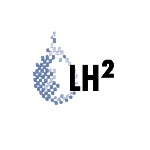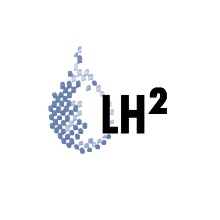Key Aspects and Aims in Research and Education
On 1st October 2000, Rainer Helmig left TU Braunschweig to take up his appointment as Professor of the newly founded Department of Hydromechanics and Modelling of Hydrosystems. He was the designated successor to Helmut Kobus, at that time Professor for Hydraulics and Groundwater at the Institute of Hydraulic Engineering. In the meantime, following new appointments in the other departments and a general re-structuring and re-orientation, the institute has been re-named the Institute for Modelling Hydraulic and Environmental Systems.
The Department of Hydromechanics and Modelling of Hydrosystems (LH2) played and plays a leading role in the International Research Training Group NUPUS (Non-Linearities and Upscaling in Porous Media, 2007 - 2016) and, since 2018, in the Collaborative Research Centre 1313 (SFB 1313) as well as making significant contributions to the Cluster of Excellence SimTech. The resulting increase in co-operation with international partners has led to very high visibility, reflected, for example, in numerous publications, invitations to conferences and meetings as well as distinctions. For instance, the US National Groundwater Association (NGWA) named Rainer Helmig Henry Darcy Distinguished Lecturer for the year 2015. With NUPUS and SFB 1313, the department has taken on additional administrative and management responsibilities.
One particularly notable event was the XX. International Conference on Computational Methods in Water Resources organised and hosted by the department. Held in 2014 on the University of Stuttgart’s campus, it was attended by some 400 researchers.
The Department continues to focus on modelling, while the application areas now extend beyond classic hydrosystems. Research at LH2 is undertaken in the broad field of flow in porous media. In recent years, due to intensive research on "porous media", the University of Stuttgart has become an important centre of competence in this field.
At LH2, fundamental research and applied science are well balanced, both in a highly interdisciplinary international context. The aim is to ensure a close interaction of research, teaching and advanced training as well as technology transfer to engineering practice. Over recent decades, the classic research methods - theoretical and experimental research - have been extended to include a new mainstay: the numerical simulation of complex coupled physical processes using ever more powerful hardware in combination with steadily developing software concepts. This has added significantly to the quality of the research and has opened up promising new opportunities. LH2 considers itself strongly connected to the fields of modelling hydrosystems and hydroinformatics, obtaining the necessary experimental support from, for example, the Research Facility for Subsurface Remediation (VEGAS) located at the institute as well as through co-operation with national and international partners, currently in particular in the framework of the Stuttgart Research Partnership NUPUS and SFB 1313. For young scientists, a variety of challenging and demanding tasks result from this broad range of research activities.
Research at LH2 includes developing methods for coupling hydrosystem compartments and complex flow and transport processes as well as integrating data and hydrosystem models. Special emphasis is laid on the development and practical engineering application of simulation methods and techniques for describing single- and multi-phase flow and transport processes in the sub-surface and in porous and fractured-porous media.
A range of research projects is underway, financed by various funding agencies. Among these are the German Research Foundation (DFG) - currently in particular in SFB 1313 -, the Federal Ministry of Education and Research (BMBF), the EU, the "Landesstiftung Baden-Wuerttemberg" and industry. The projects deal with the single-phase flow of water or air, the two-phase flow of water and gas or contaminants (NAPL) as well as the isothermal and non-isothermal three-phase flow of water, gas and organic fluids, where particular attention is paid to multi-component transport processes and phase transitions of the components. Current research topics concern the development of special techniques and discretisation methods for multi-phase flow, upscaling / downscaling and multi-scale investigations, parameter identification, fracture-matrix systems, model coupling for various flow compartments (free flow / porous media) or data assimilation. A further subject of intensive study is the coupling of flow with chemical or bio-chemical processes.
The application areas of these research topics were and are, for example, pollutant dispersion in the sub-surface, thermally enhanced remediation technologies, CO2 storage in deep geological formations, radioactive waste-disposal problems, methane migration from abandoned mines, gas and water management in fuel cells, filters, desiccation and salinization of soils, gas storage in the sub-surface as well as flow and transport in blood vessels and tissue in the human body.
With such a range of topics, it is evident that the problems can only be solved in an interdisciplinary way and in teamwork. This is reflected not only in numerous co-operations but also in the fact that at LH2, civil and environmental engineers work hand in hand with mathematicians, computer scientists, physicists and material scientists.
One of LH2's primary aims is to provide comprehensive, high-quality interdisciplinary training, predominantly for students of the study programmes Environmental Engineering, Civil Engineering and Simulation Technology as well as the international master's programmes WAREM (Water Resources Engineering and Management) and COMMAS (Computational Mechanics of Materials and Structures). In addition, the department aims to attract students from other disciplines such as mathematics, computer sciences or process engineering. The courses deal with the fundamentals of fluid mechanics, the modelling of hydrosystems, the description of exchange and transport processes in flows; more advanced lectures present the theory and numerics of flow and transport in porous media. In addition to the lectures, which are held in German as well as, to a large extent, in English, various seminars are organised in co-operation with other faculties, e.g. as part of SRC SimTech.
Current research is integrated in teaching as well as in bachelor and master projects with the aim of giving the graduates particularly well-founded expertise in the field of modelling flow in porous media, a rare educational feature.
LH2 is involved in a number of doctoral programmes. Together with the "International Graduate Program Environment Water" (ENWAT), established in 2001, these are the DFG graduate schools of the Cluster of Excellence Simulation Technology and of the International Research Training Groups NUPUS (2007 - 2016) and DropIT (since 2016) and of SFB 1313 (since 2018).
One important feature of the activities of LH2, the institute as a whole or SFB 1313 is the modern multimedia lab (MML), set up in 2001 by the University of Stuttgart with the necessary media technology and equipment and subsequently re-equipped with new technology financed from the department's budget, tuition fees or, more recently, quality assurance funding. Various teaching activities at bachelor, but mainly at master level, as well as training courses use the MML, mainly so as to be able to carry out computer exercises efficiently. In addition to the MML, LH2 has a powerful computer network and makes use of the University's high performance computing centre's parallel computing facilities.
The open-source simulator DuMuX (www.dumux.org), based on the numerics platform DUNE, was developed at LH2 and is being continuously extended and improved. DuMuX can be considered as the department's research lab. The software and programming environment serves not only doctoral researchers, but also students preparing their master's or bachelor's theses as a powerful base for their implementations or simulations. The development and maintenance of DuMuX, its provision for external users as well as user support require a great deal of time and work, only possible with a committed team and experienced leadership.
Contact



